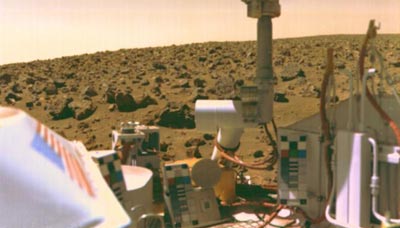Cleaning up after Martian explorationWhat happens if we find life on Mars? Pick up our trash, says one scientistby Jeff Foust
|
| Even the spacecraft that passed the strictest “planetary protection” protocols, though, harbored at least some terrestrial life forms when they landed on the surface of Mars. |
The one scenario that would cause the most problems for future exploration, McKay believes, is if past life did exist on Mars and it was a “second genesis”, that is, was completely independent of the formation of life on Earth. “This has profound scientific and philosophical implications,” he said. “It poses novel ethical questions regarding how we treat aliens.”
Right now we don’t know which of the three scenarios is actually true, although McKay said that the second—a common origin to Martian and terrestrial life—is the leading contender. However, McKay argues that if the third scenario turns out to be true, we must be prepared to do what’s necessary to protect that Martian life from terrestrial contamination.
As already noted, the spacecraft that have landed on Mars to date carry terrestrial bacteria, despite the best efforts of some missions to sterilize their spacecraft. (He noted that the sterilization process may have, in fact, made some bacteria more likely to survive the journey to Mars.) However, those that survived the trip are not thriving. Ultraviolet light from the Sun, unchecked by the Martian atmosphere, acts as a sterilizing agent itself, killing any bacteria exposed to the Sun.
Those sheltered from the ultraviolet light, either within the spacecraft or in its perpetual shadow, are most likely in a dormant state. The cold conditions and lack of liquid water will not kill the bacteria, but will also prevent them from growing. “Except for the ultraviolet light, Mars has the perfect conditions for storing organisms,” McKay said. Under those conditions the bacteria could remain dormant but viable for thousands to hundreds of thousands of years, until cosmic rays finally killed the bacteria.
| “No matter how extensive our exploration is, we can reverse it,” McKay said. “The Martian environment works with us and makes it easy to reverse our effects.” |
This means to McKay that if true Martian life is found, it will be necessary to remove terrestrial contamination before the bacteria were somehow transported, for example, to some more hospitable environment below the surface. However, the fact that any bacteria that survived the trip is dormant, and can be killed by simple exposure to ultraviolet light, makes it straightforward to reverse our exploration and remove the contamination.
“No matter how extensive our exploration is, we can reverse it,” McKay said, while showing an illustration of a proposed human habitat on Mars. “The Martian environment works with us and makes it easy to reverse our effects.”
Such a “biologically reversible exploration” would be neither cheap nor easy, McKay admitted. It would involve, as one example, retrieving the debris from the Mars Polar Lander crash site. He estimates that the cleanup could cost three to four times the exploration itself. It would be simpler, he said, if the concept of reversible exploration was incorporated into missions during their design phases: it’s simpler to do retrieval and sterilization if it is built into the spacecraft to begin with, rather than done after the fact.
